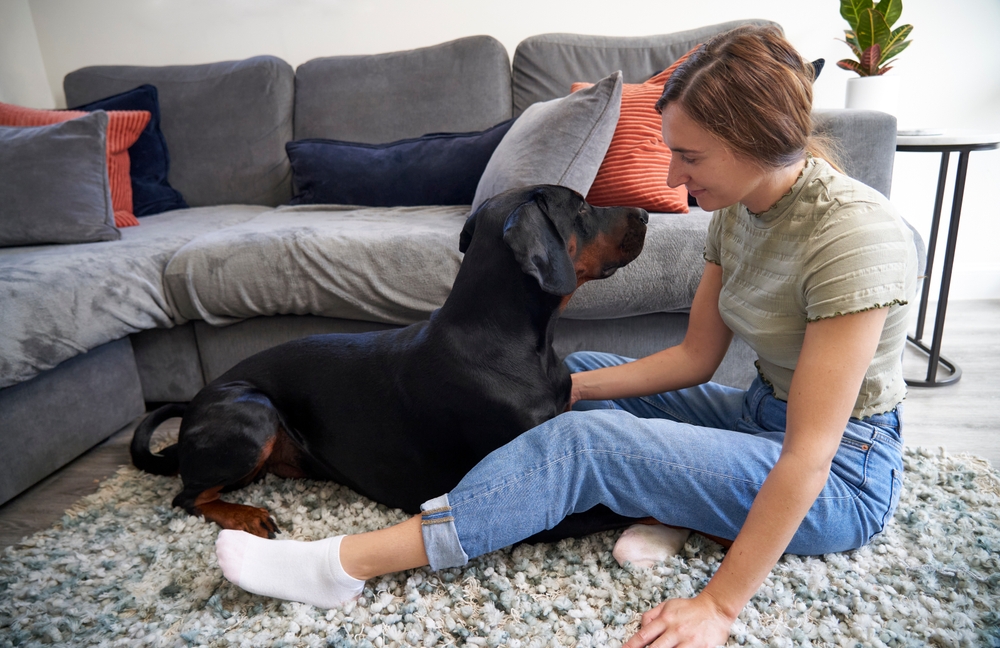If you purchased your dog from a breeder, chances are that you can celebrate their birthday with confidence. But if you rescued your dog or acquired them through another route and their birthdate isn’t known, you may wonder how old they are.
There are ways to tell a dog’s age, but keep in mind that these will only yield an estimate, not an exact number for your pup. Fortunately, though, an estimate will usually suffice for anything of extreme importance. Here are a few ways to figure out how old your dog is.

The 5 Ways to Tell Your Dog’s Age
1. Check the Paperwork
If your dog came with any paperwork, including a registration certificate, bill of sale, veterinary records, or adoption papers from a shelter, it will often list an age or birthdate. While this would be the easiest and most accurate way to find out your dog’s age, it isn’t possible for every pup, as some dogs are paperless.
You can also try checking with your vet. They should have records going back to the first time that you brought in your dog, and if they were a puppy then, that will definitely help give you a more accurate age. If they were an adult at the time, the vet likely estimated their age at that first visit and documented it. Now all you have to do is add up the years since that visit to know how many candles your dog will be blowing out on their next birthday pup-cake.

2. Check Their Teeth
Paperwork aside, a dog’s teeth can tell their life story and even give a timeline. Checking a dog’s teeth is more accurate before they’re 6 months old, but it can still be used with other determining factors after that point.
Puppies
Puppies get their first baby teeth between 3 and 6 weeks of age. These are skinnier and sharper than adult teeth. These baby teeth remain until the puppy is about 12 weeks of age, which is when the adult teeth start to come in. The tiny incisor teeth in the front and the canine teeth are first to be replaced with adult teeth, with premolars and molars coming in by the time that the dog is 6 months old. So, if they let you, look into your puppy’s mouth, and see which teeth they have and what kinds they are.
Adults
After the adult teeth come in, it’s harder to determine a dog’s age, but they can still be used for estimates. Rather than the types of teeth, you’ll be looking at coloring, wear and tear, and tartar accumulation. Generally, the older the dog, the worse shape their teeth are in. Senior dogs tend to have discoloration, worn or broken teeth, and tartar buildup. However, this method doesn’t account for regular veterinary teeth cleanings, which keep teeth in better shape, or actions like chewing rocks that can make a dog’s teeth seem older than they are.
3. Check Their Body
Besides teeth, you can check out the rest of your dog’s body to estimate how old they are. Age-related changes to the body will be highly variable, though, depending on the dog’s lifestyle.
Haircoat
Some dogs will start to get gray hair as they age. These usually start around the muzzle and eyes but can extend to the legs and paws. Dogs will start to turn gray at different ages based on genetics, or you may notice gray hairs popping up at the sites of old injuries.
Eyes
As dogs reach the top of the age hill and start down the other side, you may notice changes in their eyes. Normal aging processes, such as lenticular sclerosis, can result in a cloudiness or bluing of the eyes. Dogs can also develop cataracts with age, which can lead to cloudiness and loss of vision.
Paws and Muscles
As a general rule, a dog’s paws get thicker and their muscles get thinner with age. So, compared to a puppy’s paw pad, an older dog’s will be thick and cracked rather than soft and squishy. They may also have a bit of wasting of the muscles, which is particularly noticeable in the hind legs.

4. Watch How They Look, Listen, and Move
Due to normal aging, a dog’s vision and hearing may decrease as they get older. Unless a puppy is born with a congenital issue or has an injury, they should have great hearing and vision as a young dog. As they get older, you may notice a gradual degradation in these senses.
You may also notice a slowing down of your dog’s activity, and regular movement may even become difficult or painful. Dogs that are slow to stand up from sitting or lying down or that seem sore after a moderate walk may be a bit on the older side.
When your dog reaches their golden years, you may start to notice a decline in their cognitive function. They may forget tricks and commands that they once knew or have issues with becoming disoriented or lost. Some dogs even seem to change personalities, going from an independent soul to a worrisome, clingy type.
5. Ask Your Vet
If all of this seems like too much, don’t be afraid to talk to your vet. They will use the same guidelines to estimate the age of your dog, but they will likely have more practice at it and have seen more dogs with which to compare.
Vets can also direct you toward a DNA test if you’re interested in getting a more definitive number.
If you need to speak with a vet but can't get to one, head over to PangoVet. It's our online service where you can talk to a vet online and get the advice you need for your dog — all at an affordable price!

Why Should You Know Your Dog’s Age?
Celebrating the correct birthday for your dog is fun, but a dog’s age is also a great predictor of when they need to start increasing their veterinary visits, the normal aging processes that you should be aware of, and when to switch up their nutrition and exercise routines.
If you know your dog’s breed, their age can also give you a general idea of how much time you have left with them.


Final Note
Knowing your dog’s age comes in handy when planning birthdays and when you’ll need to start making changes in their nutrition, exercise, and veterinary care. If you don’t know your dog’s birthdate, it can be a bit difficult, but these methods can help you get an age estimate that should be close enough to provide your pet with the care that they require for the life stage they happen to be in.
Featured Image Credit: gemphoto, Shutterstock


















